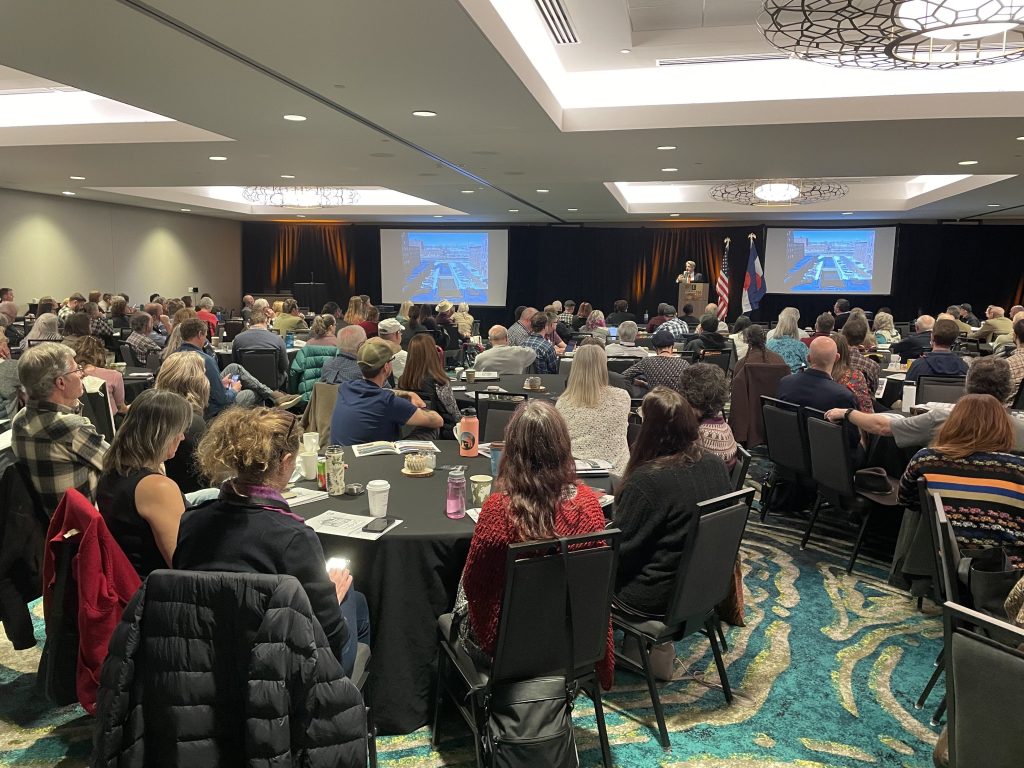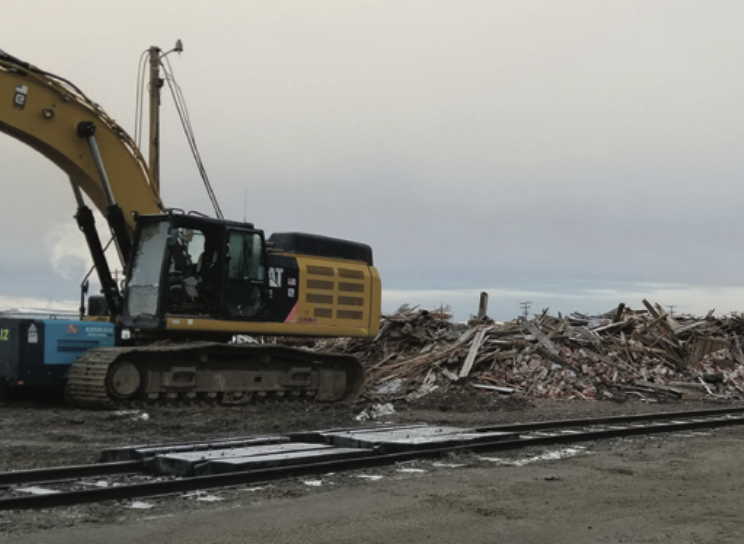
Boulder (February 9, 2023)—Colorado’s Most Endangered Places, a signature program of Colorado Preservation, Inc., which works with communities across the state to save threatened or endangered historic buildings and sites, announced five new sites to its Most Endangered Places List at the annual Saving Places Conference at the Hilton Embassy Suites in Boulder on Thursday, February 9, 2023.
The Most Endangered Places Program provides advocacy, awareness, and technical assistance to significant historic sites throughout Colorado that are in danger of being lost. In 26 years, the program has highlighted 135 historic sites throughout the state; 55 sites have been SAVED, and only eight have been lost, with 50 actively in progress and 22 still under alert status.
2023 SAVE: The San Luis People’s Market (the R&R Market)
After a successful transition to new ownership and completion of $94,306 in rehabilitation work, the oldest continuously operating business in Colorado, formerly known as the R&R Market and now known as the San Luis People’s Market, has been saved from an uncertain fate. Long time San Luis Valley resident, Dr. Devon Peña, who founded the Acequia Institute to promote water democracy, resilient agriculture, and environmental justice in the San Luis Valley, has taken on the challenge of operating the market, which has always been much more than just a grocery store. The Acequia Institute received a $1.5 million grant from the Colorado Health Foundation to help with acquisition of the R&R Market and its re-branding and transition to a new business model that ties the operation into the larger program initiative for Culebra River Acequia (community irrigation ditch) Communities in the Upper Rio Grande bioregion.
2023 LOST: The Craig Depot
Constructed in 1917, the Craig Depot was exceptional in the history of the small town of Craig. According to an article in the Craig Daily Press, “the depot was crowded to the doors and part of the ceilings with happy dancers and one of the most delightful times of the winter-spring season was had.” The Moffat Line and the Craig Depot were the hub of activity for transporting livestock, coal, supplies, and people to and from the isolated area. By the 1950s, more wool was shipped by rail from Craig than from any other place in the world. The depot served both Utah and Wyoming in addition to residents of northwest Colorado.
The Craig Depot operated until 1985 when the Denver & Rio Grande Railroad shut its doors. At the time of its listing on Colorado’s Most Endangered Places in 2008, the building sat vacant and exposed to the elements. Over the past decade, significant damage and vandalism had afflicted the building. Sitting between active railroad tracks, negotiations began to move the quickly deteriorating building. The Union Pacific Railroad, the Town of Craig, the Wyman Museum, the Museum of Northwest Colorado, the Rocky Mountain Railroad Heritage Society, and Colorado Preservation, Inc. all attempted to finance and arrange for the Depot to be moved. Unfortunately, funding fell through and the Craig Depot was demolished in April 2022.


The five sites added to Colorado’s Most Endangered Places in 2023 are:
Far View Visitor Center (Montezuma County)
Constructed in 1967 and opened to the public in 1970, the Far View Visitor Center at Mesa Verde National Park was one of the first visitor centers of the National Park Service. An initiative of Mission 66, designed to enhance and expand visitor experience and services at National Parks nationwide, the Far View Visitor Center sits within the Far View complex at Mesa Verde. It overlooks the canyons, mesas, and landmarks that are significant to the many native cultures of the region. Denver architects Joseph and Louise Marlow designed this unique, circular building, and it continues to retain its historic character.
Since its closing in 2012, the National Park Service has identified several uses for the Far View Visitor Center, but due to the building’s current condition, none have come to fruition. By listing the Visitor Center on Colorado’s Most Endangered Places, CPI hopes to partner with the National Park Service to begin a formal process to explore adaptive reuse options for this unique, one-of-a-kind structure.
Feminilas Building (Costilla County)
Located near San Francisco Creek in the San Luis Valley, the Feminilas Building is the only known structure separately owned and operated by the women’s auxiliary of men’s labor organization, La Sociedad Protección Mutua de Trabajadores Unidos (SPMDTU). The Feminilas provided aid to the afflicted and bereaved, similar to the Penitentes, a men’s group associated with the Catholic Church.
Constructed around 1920, the small adobe building, complete with vigas and latillas popular in the region, is in poor condition. It suffers from weather exposure, deterioration, and is in danger of collapse. Preservation of the Feminilas Building would help preserve the unique lifeways, language, and culture of the San Luis Valley and the traditional contributions of Hispanic women. CPI will work with the property owners and local stakeholders to stabilize, rehabilitate, and highlight the role of women’s auxiliaries in Colorado history.
Garcia School (Costilla County)
Constructed in 1913, the Garcia School was one of 11 adobe schools built in Costilla County in the San Luis Valley before the consolidation of Centennial School District R-1 in 1963. Listed on the State Register of Historic Properties, the building is one of the last structures of Plaza de Los Manzanares, the site of the first European settlement in Colorado. The Garcia School retains many historical elements but suffers from weather exposure, deterioration, lack of maintenance and funding, and an isolated setting.
The Centennial School District has received $3.5 million in grant funding from the Colorado Health Foundation to build out internet in nearby San Luis and establish a remote learning center at the Garcia School. CPI will help the school district develop partnerships and access technical assistance to preserve the building and create an accessible location for rural students.
Koch Homestead (Pitkin County)
Also known as the Adelaide Ranch, the Koch Homestead consists of five relatively intact but deteriorating buildings in the Hunter Creek Valley near Aspen. Today, only a few know of the origins of these historic structures, even though they played a significant role in the early settlement and development of Aspen. Beginning in 1887, the Koch Homestead provided local meat, produce, dairy, lumber, and freshwater to the first miners and settlers in Aspen. It also was the first hydro plant in the area.
Now owned by the U.S. Forest Service, the Koch Homestead sits along popular trails and has been determined preliminarily eligible for the National Register of Historic Places. The 60-acre site is a treasure that was the impetus for founding the Hunter Creek Historical Foundation, a nonprofit dedicated to stabilizing and preserving historical resources to enhance the public’s awareness, enjoyment, and stewardship of the valley for future generations. The Foundation recently partnered with Historicorps and stabilized the Shop building. There are plans for the Road House and Dam Keepers Cabin in the coming years.
CPI believes that it is essential that historic structures on the Koch Homestead remain intact as a testament to those early settlers for the public to understand and appreciate.
South Platte Hotel (Jefferson County)
Constructed in 1913 after the previous 1887 hotel caught fire during a tragic homicide, the South Platte Hotel symbolizes Colorado’s narrow gauge railroad history, early tourism, and summer cabin communities. Located in the North Fork Historic District, the hotel is the only remaining building left of the South Platte community.
Abandoned and left to the elements, the South Platte Hotel has been owned by Denver Water since 1987 and is slated for demolition. Strong support lies in the local community, and the building has the potential to support nearby recreational activities, which now define the region. CPI hopes to partner with Denver Water, the Jefferson County Historical Commission, and other local nonprofits to develop a plan for the adaptive reuse of the building.



